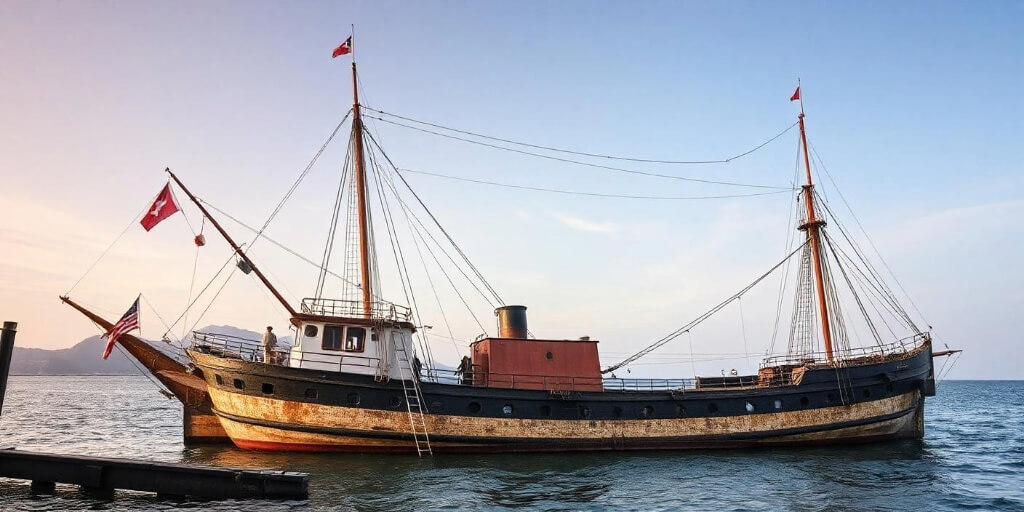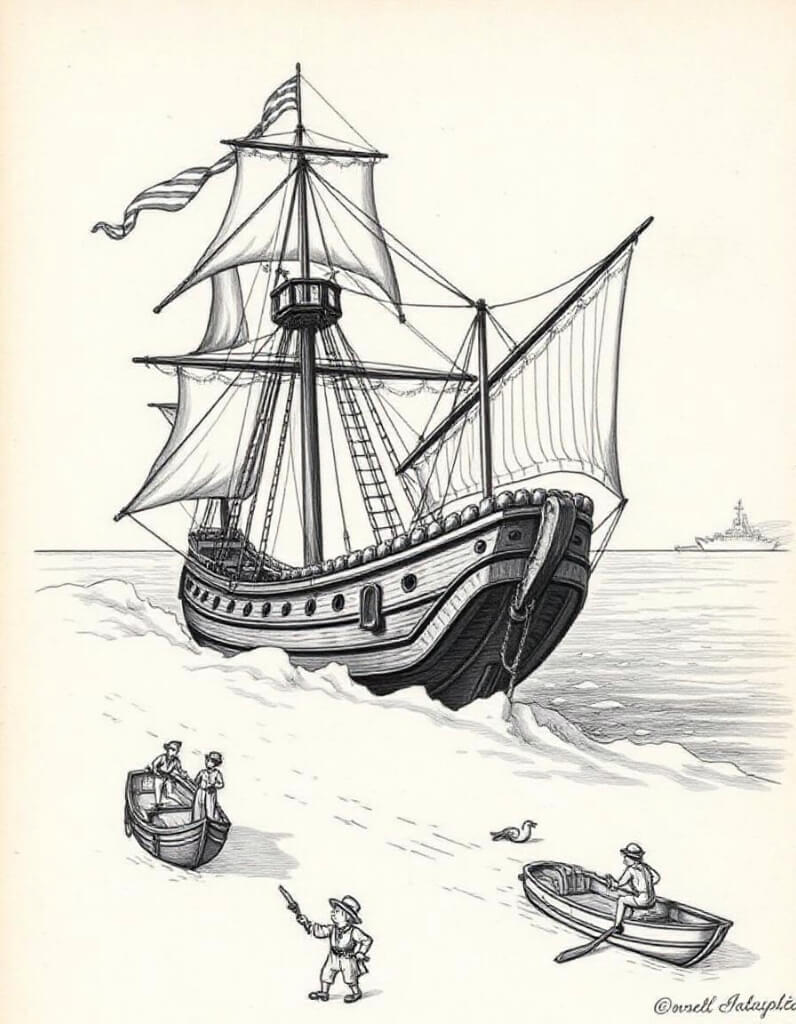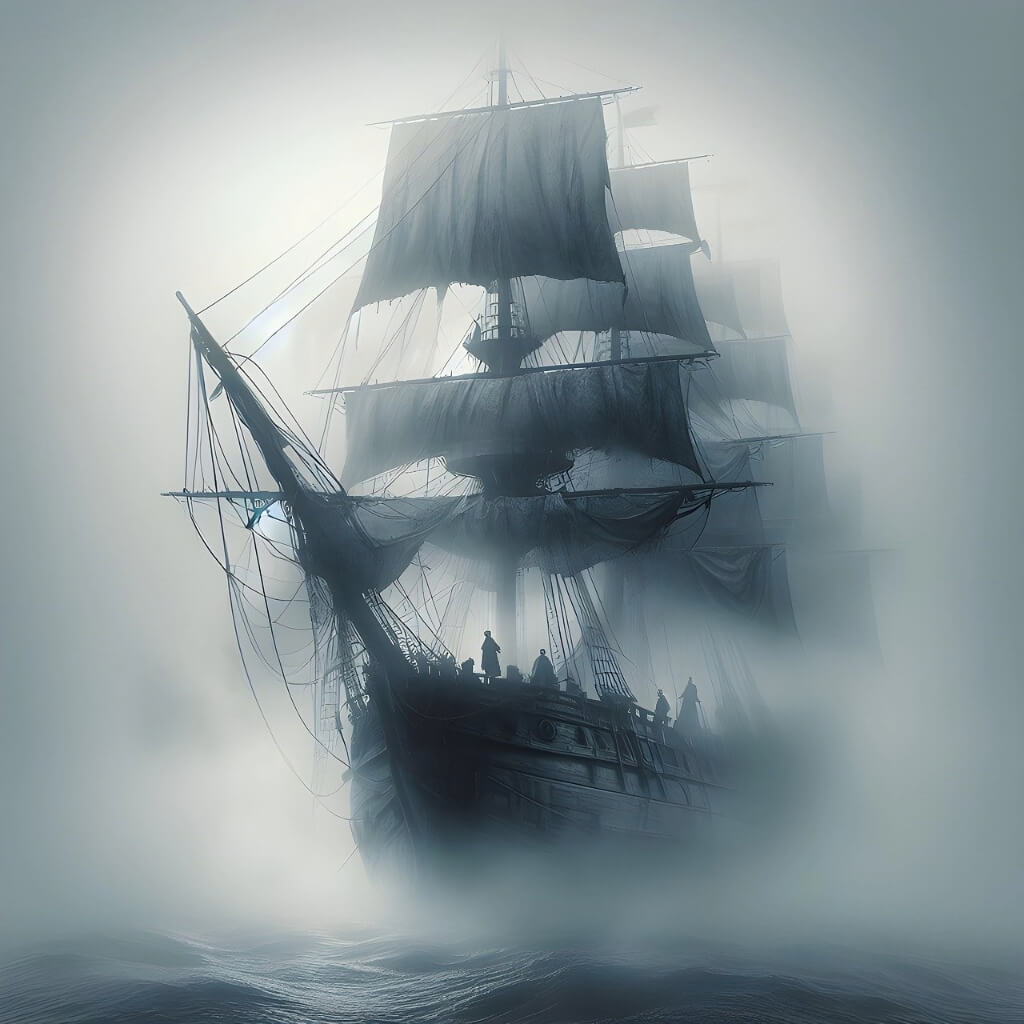Ships have been integral to human progress, shaping civilizations and enabling exploration across the globe. The invention of the ship marks one of the most significant advancements in history, transforming trade, warfare, and travel. This article delves into the origins of shipbuilding, exploring various cultures and innovations that have contributed to maritime technology development. Our journey will uncover who the first ship inventor might have been and how different societies contributed to the evolution of shipbuilding.

The Early Beginnings Of Shipbuilding
The early beginnings of shipbuilding can be traced back to prehistoric times when early humans first ventured beyond the confines of land. The earliest watercraft, such as simple rafts made from logs or reeds, were crucial for navigating rivers and lakes, providing a means of transportation and fishing that was vital for survival. These primitive vessels were essentially floating platforms, but they represented a significant leap in human ingenuity and adaptation. As communities grew and settled near larger bodies of water, the need for more advanced vessels became apparent. This led to the development of dugout canoes, crafted from hollowed-out tree trunks, which were more stable and capable of longer voyages compared to rafts.
With these early designs, the fundamental principles of shipbuilding began to emerge. The introduction of sails, although rudimentary at first, allowed these early ships to harness wind power, making travel more efficient and expanding their range. The use of rudders and side planks further enhanced maneuverability and stability. These innovations were not just incremental improvements but represented a profound shift in how humans interacted with their aquatic environment. Early shipbuilders experimented with various materials and techniques, gradually refining their designs to create vessels that could handle more diverse and challenging conditions. The evolution of these early ships laid the foundation for the more sophisticated maritime technology that would follow, marking the beginning of a rich and transformative history in shipbuilding.
Prehistoric Watercraft
Prehistoric watercraft represent some of the earliest manifestations of human ingenuity in maritime technology. The simplest of these, rafts, were constructed from bundled reeds or logs lashed together, creating a stable platform for floating on rivers, lakes, and coastal waters. These rafts were primarily used for transportation, allowing early humans to move goods and people more efficiently across water bodies than they could on land. Their design was straightforward but effective, showcasing an early understanding of buoyancy and stability.
As technology progressed, early humans developed dugout canoes, which marked a significant advancement in watercraft design. Crafted from large tree trunks hollowed out by carving or burning, these canoes were more streamlined and capable of handling open water conditions better than rafts. The ability to carve and shape wood allowed for more control over the vessel’s performance and improved its capacity for carrying passengers and cargo. Dugout canoes also introduced the concept of a hull, a crucial feature in modern ship design, which provided a more stable and efficient means of travel.
These early watercraft were often adorned with simple sails made from animal hides or woven materials, enabling them to harness wind power for propulsion. This innovation expanded their range and efficiency, allowing early maritime cultures to explore further and engage in trade. The development of rudimentary paddles and oars also played a crucial role in maneuvering these vessels, enhancing their versatility.
Overall, prehistoric watercraft were not merely functional tools but also reflections of the evolving ingenuity of early human societies. They laid the groundwork for future advancements in shipbuilding, demonstrating an early understanding of key principles such as buoyancy, stability, and propulsion that would be refined over millennia.
The Evolution Of Early Ships
As societies advanced, so did their shipbuilding techniques. From simple rafts, early shipbuilders progressed to more complex structures, incorporating sails and rudders. Environmental factors such as river currents and sea conditions influenced the design and construction of these vessels. Innovations such as the addition of sails allowed for longer journeys and greater mobility, setting the stage for developing more advanced ships.
As early civilizations expanded their maritime capabilities, the evolution of ship design became increasingly sophisticated. The transition from simple rafts and dugout canoes to more advanced ships involved a series of significant innovations. Early builders began incorporating sails, which allowed for more efficient travel by harnessing wind power, and rudders for improved steering and control. The development of planking techniques, where wooden boards were fastened together to form the hull, marked a leap in shipbuilding, providing greater durability and stability. Additionally, the introduction of the keel—a central structural element running along the bottom of the ship—enhanced stability and helped in navigating rougher waters. These advancements not only increased the range and effectiveness of early ships but also laid the groundwork for the complex maritime vessels that would follow. As societies faced diverse maritime challenges and opportunities, their ship designs continued to evolve, reflecting a growing understanding of nautical engineering and a relentless drive for exploration and trade.

Ancient Maritime Cultures
Ancient maritime cultures were pivotal in the advancement of shipbuilding, each contributing unique innovations that shaped the course of naval history. The Egyptians, with their reliance on the Nile River, developed a range of boats from simple reed vessels to sophisticated wooden ships like the “Khufu Ship,” which exemplified their advanced maritime technology. Meanwhile, the Phoenicians, renowned for their seafaring prowess, introduced the bireme and trireme—ships with multiple rows of oars that enhanced speed and maneuverability, playing a crucial role in Mediterranean trade. The Greeks further advanced naval architecture with the trireme, a formidable warship with three tiers of oars, while the Romans improved ship design for both warfare and commerce, utilizing stronger materials and more efficient hull shapes. Each of these cultures not only pushed the boundaries of shipbuilding but also set the foundation for future maritime advancements.
The Egyptians
The ancient Egyptians made significant strides in shipbuilding, particularly due to the vital role of the Nile River. The Egyptians constructed a variety of boats, from simple reed vessels to more elaborate wooden ships. One of the most famous examples is the “Khufu Ship,” an ancient vessel found in a tomb near the Great Pyramid of Giza. This ship reflects the Egyptians’ advanced shipbuilding skills and their understanding of maritime technology.
The Phoenicians
The Phoenicians were renowned for their innovations in ship design. They developed the bireme and trireme, ships with two or three rows of oars on each side, which enhanced their speed and maneuverability. The Phoenician ships were pivotal in establishing extensive trade networks across the Mediterranean, highlighting their mastery of maritime engineering and navigation.
The Greeks And Romans
Greek shipbuilders advanced naval technology with the development of the trireme, a highly efficient warship equipped with three rows of oars. The Greeks’ contributions to shipbuilding were further expanded by the Romans, who refined ship designs for both warfare and trade. Roman innovations included improvements in hull construction and the use of more durable materials, which contributed to their dominance on the seas.
Medieval Maritime Innovations
During the medieval period, maritime technology saw transformative innovations that enhanced navigation and shipbuilding. The Vikings, renowned for their longships, designed vessels with a shallow draft, allowing them to navigate both open seas and shallow rivers with remarkable agility. Their longships, with their symmetrical bow and stern, facilitated long voyages and swift raids, making them a formidable force in Northern Europe. Concurrently, Chinese shipbuilders developed the junk, a revolutionary design featuring watertight compartments and advanced rigging that significantly improved the vessel’s durability and maneuverability. These medieval innovations not only expanded the range of maritime exploration but also laid the groundwork for future advancements in shipbuilding and navigation.
The Vikings
The Viking longships are iconic examples of medieval maritime technology. Designed for both open-sea voyages and shallow-water navigation, these ships allowed the Vikings to explore and conquer vast territories. The longship’s sleek design and advanced construction techniques made it one of the most effective vessels of its time, showcasing the Vikings’ exceptional shipbuilding skills.
The Chinese
China’s maritime history includes notable advancements, particularly during the Song and Ming Dynasties. The Chinese developed the Junk, a ship renowned for its durability and versatility. With watertight compartments and advanced rigging systems, junks were pivotal in facilitating trade and exploration. Chinese innovations in shipbuilding significantly influenced maritime practices across Asia and beyond.
The Age Of Exploration
The Age of Exploration, spanning the 15th to the 17th centuries, marked a pivotal era in shipbuilding and maritime history, driven by Europe’s quest for new trade routes and territories. This period saw the development of more advanced ship designs, such as the caravel, which featured a combination of square and lateen sails, enabling it to sail more efficiently against the wind. The galleon, another key innovation, was larger and sturdier, equipped for long voyages and armed with cannons for defense. Explorers like Christopher Columbus, Vasco da Gama, and Ferdinand Magellan relied on these innovative ships to undertake ambitious expeditions that connected continents and opened up new trading opportunities. Additionally, advancements in navigation, including the use of the astrolabe and compass, allowed sailors to navigate the vast oceans with greater accuracy. These innovations not only facilitated the discovery of new lands but also laid the foundation for a global exchange of goods, ideas, and cultures, significantly altering the course of world history.

The Age of Exploration was marked not only by daring voyages but also by remarkable advancements in maritime technology that facilitated these epic journeys. The design of ships like the caravel, with its combination of lateen and square sails, allowed for greater maneuverability and efficiency in various wind conditions. This adaptability proved crucial for explorers navigating unknown waters. The galleon, another significant innovation, combined heavy firepower with a robust design, making it ideal for both long voyages and naval combat. Additionally, the period saw the refinement of navigational instruments, such as the astrolabe and sextant, which improved the accuracy of celestial navigation and allowed sailors to chart their courses more precisely. These technological advancements, alongside the bold ambitions of explorers such as Columbus, da Gama, and Magellan, not only expanded geographic knowledge but also established new maritime routes that would reshape global trade and cultural exchange for centuries to come.
The Renaissance And Ship Design
The Age of Exploration, marked by the Renaissance, saw a dramatic evolution in ship design. The development of the caravel and galleon enabled longer and more reliable ocean voyages. Explorers like Christopher Columbus, Vasco da Gama, and Ferdinand Magellan relied on these advanced ships to undertake groundbreaking expeditions, expanding European knowledge of the world and establishing new trade routes.
Advances In Navigation And Shipbuilding
The Renaissance also introduced crucial navigational tools, such as the astrolabe and compass, which revolutionized maritime exploration. These instruments enhanced the accuracy of sea travel, allowing for more precise navigation and longer voyages. As a result, shipbuilders could design vessels that were better suited to the challenges of long-distance travel.
The Industrial Revolution And Modern Shipbuilding
The Industrial Revolution ushered in a new era of shipbuilding, characterized by groundbreaking technological advancements and the shift from sail to steam power. The introduction of steamships revolutionized maritime travel, as steam engines provided consistent propulsion regardless of wind conditions, allowing for more reliable and efficient voyages. One of the most notable early steamships was the “SS Great Britain,” designed by Isambard Kingdom Brunel, which showcased innovations in iron hull construction and steam propulsion. This period also saw the rise of iron and steel ships, which replaced wooden vessels with stronger, more durable materials. The advent of these modern materials and technologies enabled the construction of larger and more powerful ships, transforming global trade and naval warfare. As shipbuilding continued to evolve, the advancements made during the Industrial Revolution laid the foundation for the sophisticated maritime industry we know today.
The Advent Of Steamships
The Industrial Revolution marked a significant turning point in shipbuilding with the advent of steam power. The transition from sail to steam engines represented a major technological leap. Early steamships, such as the “SS Great Britain” designed by Isambard Kingdom Brunel, showcased innovations in engine design and hull construction, paving the way for modern maritime technology.

The Rise Of Modern Shipping
As the 19th and 20th centuries progressed, advancements in materials and technology led to the development of iron and steel ships. These materials offered greater strength and durability, transforming shipping practices and enabling larger vessels. Modern shipping innovations continue to evolve, reflecting ongoing advancements in technology and engineering.
Key Figures In Shipbuilding History
Throughout the evolution of shipbuilding, numerous key figures have played pivotal roles in advancing maritime technology. In ancient times, shipbuilders like the Phoenician engineers and Greek naval architects were instrumental in developing innovative ship designs, such as the bireme and trireme, which revolutionized naval warfare and trade. Moving to the modern era, pioneers like Isambard Kingdom Brunel made significant contributions with the design of the “SS Great Britain,” an early steamship that demonstrated the potential of steam power and iron hulls. Similarly, John Stevens, an American inventor, played a crucial role in advancing steamship technology in the early 19th century. These individuals, among many others, pushed the boundaries of shipbuilding, each contributing unique innovations that have shaped the maritime industry and its enduring legacy.
Ancient Innovators
Throughout history, numerous individuals have contributed to the evolution of shipbuilding. In ancient times, shipbuilders in Egypt, Phoenicia, Greece, and Rome made significant advancements that laid the foundation for future developments. These innovators are recognized for their contributions to maritime technology and their role in shaping the course of history.
Pioneers Of The Modern Era
In the modern era, figures such as Isambard Kingdom Brunel and John Stevens played crucial roles in advancing shipbuilding technology. Their innovations in steamship design and construction methods significantly influenced the development of modern shipping and naval engineering.
Final Thoughts
The journey through the history of shipbuilding reveals a rich tapestry of innovation and adaptation. From the earliest dugout canoes to the sophisticated vessels of today, the evolution of ships reflects the ingenuity and determination of countless inventors and engineers. While it is challenging to pinpoint a single individual as the “first ship inventor,” the contributions of various cultures and innovators have collectively shaped the maritime world we know today.
FAQs
Who Was The First Ship Inventor?
Identifying a single “first ship inventor” is difficult, as shipbuilding evolved over millennia. Early watercraft were developed by various ancient civilizations, including the Egyptians, Phoenicians, Greeks, and Romans. Each of these cultures made significant contributions to the development of maritime technology.
What Were Some Of The Earliest Types Of Ships?
The earliest types of ships included dugout canoes and reed boats. These simple vessels were used for transportation and fishing in rivers and lakes. As technology advanced, more complex designs such as the bireme and trireme emerged.
How Did The Age Of Exploration Impact Shipbuilding?
The Age of Exploration led to significant advancements in shipbuilding, including the development of new ship types like the caravel and galleon. Innovations in navigational tools and construction techniques facilitated longer and more accurate ocean voyages.
What Role Did The Industrial Revolution Play In Shipbuilding?
The Industrial Revolution introduced steam power to shipbuilding, revolutionizing the industry. Steamships replaced sail-powered vessels and allowed for more efficient and reliable sea travel. Advances in materials such as iron and steel also contributed to the evolution of modern shipping.
